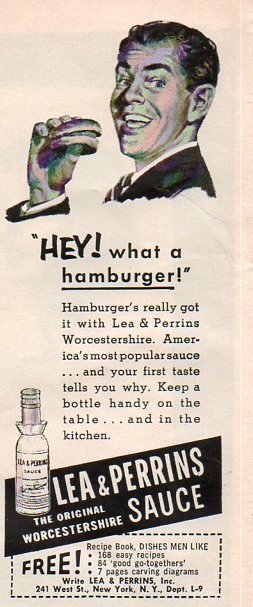JF Ptak Science Books Quick Post
 I was looking for something completely different when I stumbled over this simple ad for Worcestershire Sauce. What was instant recognizable to me was that the hamburger was just exactly that--a hamburger. There was the burger and the buns, and that was it. except of for the fancy Worcestershire sauce, brought to America from the old country. In the ultra-centrifuge micro-cautionary ads of today, it would seem impossible to show a food product in such simplicity and so remarkably unposed--the buns are uneven, and imperfect, and there's nothing about the burger to suggest itself as good except for the smiling, suited man.
I was looking for something completely different when I stumbled over this simple ad for Worcestershire Sauce. What was instant recognizable to me was that the hamburger was just exactly that--a hamburger. There was the burger and the buns, and that was it. except of for the fancy Worcestershire sauce, brought to America from the old country. In the ultra-centrifuge micro-cautionary ads of today, it would seem impossible to show a food product in such simplicity and so remarkably unposed--the buns are uneven, and imperfect, and there's nothing about the burger to suggest itself as good except for the smiling, suited man.
McDonalds was selling burgers at this time, and for 15 cents a pop. I've seen television commercials advertising burgers for a buck here in the present, cheaper than what the thing was in 1956, that dollar covering only 12 cents of expense then. The current burger is cheaper still if you consider it as part of an hourly minimum wage; the 1956 minimum was 75 cents/hour, while 2010 is about ten times that; that means that the 1956 hamburger was 1/5 of the hourly wage, while the product in 2010 was 1/7 of the minimum wage. The extreme cheapness of the current hamburger must make it seem a good deal for people working at or below the minimum wage, providing a food-like product to fill the belly for very little money in exchange, and with very little nutritional value. Perhaps that explains why 50 million Americans eat a a hamburger place of some sort every day--it is a vastly successful business model predicated on delivering an almost entirely valueless version of an essential component of daily life, with constant advertisement duping people with greasy heart clogging goodness delivered by a bouncing clown or a little girl with freckles. But of course there were worse things--this one just happened to catch my attention this morning.
The hamburger has maintained its cheapness over the years, and certainly is one of those things from the '50's whose back-then price has translated into a more-expensive price with CPI-adjustments over time. There are other staple-like thingas that were more expensive in 1956 than now: milk/gallon: 92 cents 1956 and $7.44 in 2010 dollars) and coffee, 93 cents (1956) or $7.52 (2010). Gasoline was 23 cents/gallon or $1.86 in 2010 dollars. (Gasoline pricing is another, more complicated story, for another time.)
Don't forget to order your copy of Dishes Men Like! It has seven pages of carving diagrams.



Comments